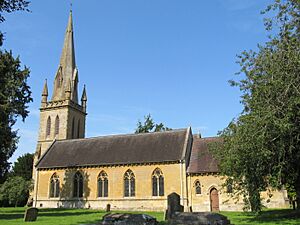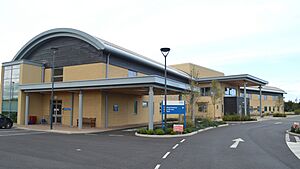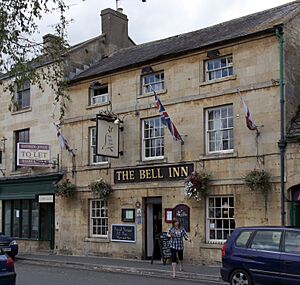Moreton-in-Marsh facts for kids
Quick facts for kids Moreton-in-Marsh |
|
|---|---|
 Redesdale Hall, Moreton-in-Marsh |
|
| Population | 5,015 (2021 Census) |
| OS grid reference | SP2032 |
| District |
|
| Shire county | |
| Region | |
| Country | England |
| Sovereign state | United Kingdom |
| Post town | MORETON-IN-MARSH |
| Postcode district | GL56 |
| Dialling code | 01608 |
| Police | Gloucestershire |
| Fire | Gloucestershire |
| Ambulance | Great Western |
| EU Parliament | South West England |
| UK Parliament |
|
Moreton-in-Marsh is a historic market town located in the beautiful Cotswolds area of Gloucestershire, England. It sits in the Evenlode Valley, surrounded by the gentle Cotswold Hills. The River Evenlode starts nearby and flows around the town before heading towards Oxford and joining the river Thames.
Just a short distance east of Moreton, you'll find the Four shire stone. This special stone once marked the spot where four historic counties met: Gloucestershire, Warwickshire, Worcestershire, and Oxfordshire. Today, it marks the meeting point of Gloucestershire, Warwickshire, and Oxfordshire.
Contents
What's in a Name?
The name "Moreton" comes from an old English phrase meaning "Farmstead on the Moor." The "in Marsh" part might mean a marshy area used by birds like moorhens. Another idea is that "Marsh" is a changed version of "March," which used to mean a boundary or border.
A Glimpse into History
People have lived in this area for a very long time! An early settlement was built during the British Iron Age, northwest of the town center. Later, after the Roman invasion of Britain, Roman pottery and coins were found here, showing that people continued to live in the area.
During Roman times, the famous Fosse Way was built. This was one of the best-preserved Roman roads in Britain. You can still see parts of its path today, as many modern roads follow its route.
Moreton was first mentioned as a Saxon settlement around 577 AD. After the Norman conquest of Britain, the land became part of Westminster Abbey's property. Between 1222 and 1246, Moreton began to grow into a medieval market town. The new town was built on common land next to the Fosse Way. The original Saxon settlement is now called Old Town, and that's where St David's Church is located. To make space for busy medieval markets, the new town was designed with a very long and wide High Street.
The town became wealthy because of wool and cloth-making in the Middle Ages. This is why you can see so many beautiful 18th-century inns and houses along the High Street.
The Curfew Tower, on the corner of Oxford Street, is quite old, probably from the 1500s. Its bell was made in 1633, and its clock in 1648. During the English Civil War, King Charles I of England even stayed at the White Hart Royal inn in 1637.
The Church of England parish church of Saint David has a long history. It started as a smaller church for Blockley. The church was rebuilt and improved over the centuries, with major work done in the 1800s.
Moreton was a perfect stopping place for stagecoaches traveling from London to Worcester. Inns like The Redesdale Arms and The White Hart Royal were very popular.
The Stratford and Moreton Tramway was built in the 1820s, connecting Moreton to the Stratford-on-Avon Canal. It started with horses pulling carts, but later, steam trains were used on part of the line. The Oxford, Worcester and Wolverhampton Railway also came through Moreton, and the railway station opened in 1853. Today, this railway line is part of the Cotswold line.
Redesdale Hall was finished in 1887 and became the town's market hall and town hall.
In 1940, during the Second World War, a large airfield called RAF Moreton-in-Marsh was built east of the town. It was used to train pilots flying Wellington bombers. Sadly, 38 men died while flying to or from RAF Moreton-in-Marsh during the war. Today, this former airfield is home to the Fire Service College, where fire officers from all over the UK receive training.
The Moreton-in-Marsh and Batsford War Memorial on the High Street remembers those who died in the First and Second World Wars. One notable person remembered is Diana Hope Rowden, a secret agent who served at RAF Moreton-in-Marsh before she was killed in a concentration camp in 1944.
Moreton used to experience floods quite often, but work done on the ditches and roads has mostly solved these problems. The last major flood was in 2007.
A Roman fort was located near Dorn, just north-west of Moreton. The annual Moreton and District Agricultural Show is held there every September. This popular show has been running since 1949.
How Moreton is Governed
Moreton-in-Marsh is represented by councillors on the Cotswold District Council. These councillors help make decisions for the local area.
Getting Around Moreton
The town has its own Moreton-in-Marsh railway station, which is on the Cotswold Line. You can catch trains to London Paddington, Hereford, and Worcester Foregate Street.
Local bus services, run by Stagecoach Midlands and Pulhams Coaches, connect Moreton to nearby towns like Stratford-upon-Avon, Bourton-on-the-Water, and Cheltenham.
The town is also at the crossroads of two main roads: the Fosse Way (now the A429) and the A44.
Things to See and Do
Moreton-in-Marsh has many buildings made from the special Cotswold stone. You'll find supermarkets, shops, antique stores, cafes, hotels, and restaurants along the High Street.
If you're interested in history, you can visit the Wellington Aviation Museum. It's a museum about the history of the Vickers Wellington bomber plane. Other nearby attractions include Batsford Arboretum, a beautiful tree garden, and the unique onion-domed Sezincote house and gardens.
The White Hart Royal is a historic inn. It's said that King Charles I stayed there during the First English Civil War in 1644 and left without paying his bill!
The Bell Inn, an 18th-century inn, was often visited by the famous author J. R. R. Tolkien when he was at University of Oxford. Some people believe it was the inspiration for "The Prancing Pony" in his book The Lord of the Rings.
The Black Bear Inn, which is 300 years old, has a fun connection to football. A former professional footballer, Jim Steele, used to be the landlord. He played for Southampton F.C. when they famously beat Manchester United F.C. in the 1976 FA Cup Final.
Local Media
For local news and TV, Moreton-in-Marsh receives signals from BBC West Midlands and ITV Central. You can also listen to local radio stations like BBC CWR and BBC Radio Gloucestershire. The town has its own weekly local newspaper, the Wilts and Gloucestershire Standard.
Sports in Moreton
Moreton-in-Marsh has its own football club, Moreton Rangers, who play at the London Road ground. The Batsford Road cricket ground, opened in 1859, has hosted professional cricket matches for Gloucestershire County Cricket Club.
Famous People from Moreton
Many interesting people have connections to Moreton-in-Marsh, including:
- Nicholas John Anstee (born 1958), a former Lord Mayor of London.
- Dame Prue Leith (born 1940), a well-known chef and TV presenter.
- Jim Steele (born 1950), a former professional footballer.
- Mark Williams (born 1959), a famous actor.
See also
 In Spanish: Moreton-in-Marsh para niños
In Spanish: Moreton-in-Marsh para niños






